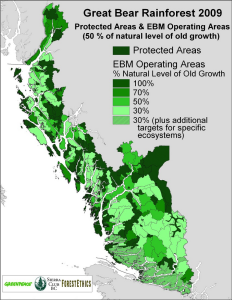The Story of the Great Bear Rainforest: Transition to Sustainability
The Great Bear Rainforest is one of the largest intact temperate rainforests in the world. It stretches from the northern tip of Vancouver Island to the Alaska Border.
 In 2000, the region was the centre of disruption. Clear cut logging was creeping up the coast; fish stocks were plummeting; environmental campaigns had basically closed timber markets across North America and indigenous peoples were desperately unemployed and shut out of the resource economy.
In 2000, the region was the centre of disruption. Clear cut logging was creeping up the coast; fish stocks were plummeting; environmental campaigns had basically closed timber markets across North America and indigenous peoples were desperately unemployed and shut out of the resource economy.
In 2020 the region was transformed into a ecosystem based resource economy, Coast Funds were available to support community projects, all decisions were consensus based through reconciliation agreements and the indigenous communities again stood on their own feet. As shown on the map below, the vast majority of the temperate rain forest is now protected from logging.
Three persons who were and still are intimately involved in guiding the transition over the past 20 years enjoy a conversation on this webinar.
Dallas Smith is the President of the Nanwokalas First Nation based on the lower third of the Central Coast. Wally Eamer, a former planner with the BC Ministry of Sustainable Resource Management was seconded to work with the Nanwokalas to develop their forestry plans. Jon O’Riordan was the Deputy Minister for the BC Ministry of Sustainable Resource Management and reported to Cabinet on policies to support the transition.
The webinar provides a unique perspective of how each of the three played various roles in the transition to sustainability through the implementation of Ecosystem Based Management. The principles of EBM are maintaining ecological integrity: promoting human wellbeing and reconciling indigenous rights and title. A number of truly innovative policies are described such as carbon credits for conserving trees, now providing the First Nations with over a $1 million per year; a Reconciliation Agreement between the Nanwokalas First Nation and the BC Government in 2011 committing to joint decision making for all resource development in the traditional territory; the establishment of a Coast Opportunities Fund of $ 120 million to support the economic development of First Nations communities across the coast.
Each participant has powerful stories to tell, sharing their hopes and challenges as they work through the transition. The job is only half completed but change is real. Much as been learned about living within nature’s means through a universal environment- based management model; learning to work as communities rather than individuals and understanding the benefits of true reconciliation where indigenous and non indigenous peoples find trust, compassion and set of common goals
This is a unique webinar portraying a unique journey of discovery.